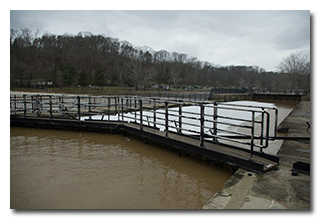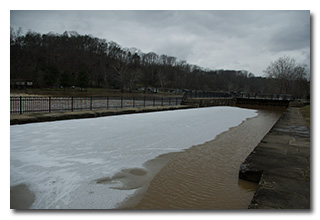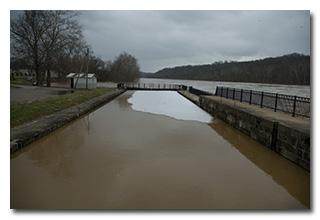
by William Eric McFadden
From the park's website:
-
The Muskingum River Parkway State Park has been placed on the National Register of Historic Places and is recognized as the Muskingum River Navigation Historic District. In its day, the system of locks and dams helped open the state and the entire Midwest to trade and development. It is the only remaining system of hand-operated locks in the nation.
The locks help boats safely bypass ten dams on the Muskingum River from Zanesville south to the Ohio River at Marietta. These locks are operated at no charge for recreational boats. Ten of the eleven locks still function— the northernmost lock, Ellis #11, is no longer in operation but offers a campground. The remaining locks have a variety of amenities and many communities along the Muskingum River offer recreational and sight-seeing opportunities for boaters and non-boaters alike. Visitors may enjoy watching the river from the park's picnic shelter south of Lock #7 on State Route 376.
From the Muskingum River Water Trail map and brochure:
-
(Devola Lock #2) was constructed between 1837 and 1841. Major repairs were made to the lock system in 2005. This lock and dam site has many names, including Devol’s, after the Devol family, one of the first families to settle in this area of Muskingum Township.
Pictures
- The Sign: "Welcome to Historic Lock and Dam #2 Devola"
- How high is the Muskingum River at Devola?
- The down-river gates
- The lock as viewed from down-river: ice inside the lock 1 | 2
- The swollen Muskingum River boiling over the dam
- The lock at viewed from up-river: ice inside the lock
Description
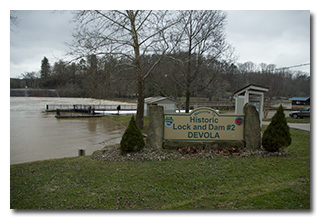 On Friday, February 18, 2022, one member of the Southeast Ohio Radio Adventure Team
performed a successful activation of Muskingum River State Park in Ohio as part of the Parks on the
Air (POTA; link) program.
On Friday, February 18, 2022, one member of the Southeast Ohio Radio Adventure Team
performed a successful activation of Muskingum River State Park in Ohio as part of the Parks on the
Air (POTA; link) program.
Having decided that his goal within POTA for the next few months would be to earn the Oasis Repeat Offender Activator Award for Muskingum River State Park by visiting all ten of the river-navigation locks and dams that make up the state park, Eric McFadden, WD8RIF, visited Devola Lock and Dam #2 on a cold, windy, gray day with spitting snow, arriving at the lock at about 1610 UTC. Eric was accompanied by little dogs Theo and Mindy.
This was to be Eric's fifth activation of Muskingum River State Park, with his previous activations having occurred at...
- Stockport Lock #6 (2018-09-15 / 2021-05-29),
- Rokeby Lock #8 (2021-02-27),
- Zanesville Lock #10 (2021-07-23).
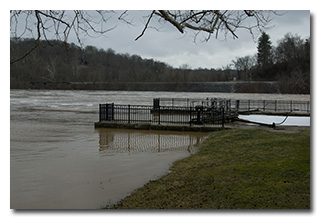 Eric had hoped to try out his newly-constructed speaker-wire W3EDP, Jr. antenna during this activation but upon arrival at
Devola Lock and Dam #2 he wasn't able to find an an easy way to deploy it at the site. Finding a parking spot overlooking a very
rain-swollen Muskingum River, Eric parked his car and, while the little dogs explored, set up his 28½' wire
vertical on a Jackite 31' telescoping fiberglass mast and drive-on mount and set up his KX3 inside the car. Eric was on the
air at 1623 UTC.
Eric had hoped to try out his newly-constructed speaker-wire W3EDP, Jr. antenna during this activation but upon arrival at
Devola Lock and Dam #2 he wasn't able to find an an easy way to deploy it at the site. Finding a parking spot overlooking a very
rain-swollen Muskingum River, Eric parked his car and, while the little dogs explored, set up his 28½' wire
vertical on a Jackite 31' telescoping fiberglass mast and drive-on mount and set up his KX3 inside the car. Eric was on the
air at 1623 UTC.
Eric was pleased to find he had good cell-signal at Devola Lock and Dam #2 and he was able to spot himself on POTA Spots (link) and to use POTA Spots to identify possible park-to-park (P2P) QSO opportunities.
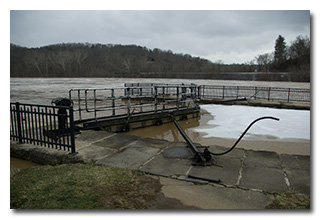 Eric began his operation by finding himself a frequency to run on 40m and began calling "CQ POTA". He was only slightly
embarrassed to find after two minutes of calling "CQ" that his KX3 wasn't generating any RF output—the previous day he
had been experimenting at home with an external keyer and had disabled VOX so he wouldn't transmit a signal, and he
forgot to turn it back on! Relieved that no one saw his blunder, after sheepishly re-enabling the KX3's VOX, Eric's first QSO came immediately at 1625 UTC with his friend
K4SWL in western North Carolina. Thereafter, QSOs on 40m came very quickly, with Eric's twenty-first QSO coming at 1646
UTC with NN9K in Illinois. This run included a P2P QSO with WG4Z who was activating Kings Mountain State Park (K-2902) in
South Carolina and QSOs with operators in North Carolina (3), New Jersey, Wisconsin, Illinois (2), Tennessee (2), West Virginia (2),
Connecticut, Ohio (2), South Carolina, Pennsylvania (3), Ontario, New York, and Maryland.
Eric began his operation by finding himself a frequency to run on 40m and began calling "CQ POTA". He was only slightly
embarrassed to find after two minutes of calling "CQ" that his KX3 wasn't generating any RF output—the previous day he
had been experimenting at home with an external keyer and had disabled VOX so he wouldn't transmit a signal, and he
forgot to turn it back on! Relieved that no one saw his blunder, after sheepishly re-enabling the KX3's VOX, Eric's first QSO came immediately at 1625 UTC with his friend
K4SWL in western North Carolina. Thereafter, QSOs on 40m came very quickly, with Eric's twenty-first QSO coming at 1646
UTC with NN9K in Illinois. This run included a P2P QSO with WG4Z who was activating Kings Mountain State Park (K-2902) in
South Carolina and QSOs with operators in North Carolina (3), New Jersey, Wisconsin, Illinois (2), Tennessee (2), West Virginia (2),
Connecticut, Ohio (2), South Carolina, Pennsylvania (3), Ontario, New York, and Maryland.
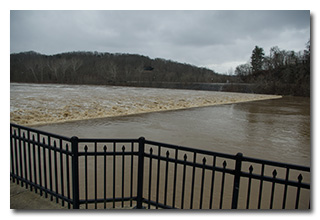 Switching to 20m at 1647 UTC, Eric found a frequency to run and began calling "CQ POTA". His first QSO on 20m came at
1651 UTC with well known POTA-hunter EC1R in Spain. This was followed at 1652 UTC with a QSO on OH1MM in Finland. QSOs
on 20m came more quickly than Eric had expected, with his twenty-fifth QSO on 20m coming at 1716 UTC with K1lB in Nevada.
This run included QSOs with county-hunter HA9RE in Hungary and EC1D in Spain and QSOSs with operators in Colorado,
California (3), Texas (2), Florida, South Dakota, New Brunswick, Alabama (3), Wisconsin (2), Missouri, Alabama, Massachusetts,
Kansas (2), Oklahoma, New Mexico, and Nevada.
Switching to 20m at 1647 UTC, Eric found a frequency to run and began calling "CQ POTA". His first QSO on 20m came at
1651 UTC with well known POTA-hunter EC1R in Spain. This was followed at 1652 UTC with a QSO on OH1MM in Finland. QSOs
on 20m came more quickly than Eric had expected, with his twenty-fifth QSO on 20m coming at 1716 UTC with K1lB in Nevada.
This run included QSOs with county-hunter HA9RE in Hungary and EC1D in Spain and QSOSs with operators in Colorado,
California (3), Texas (2), Florida, South Dakota, New Brunswick, Alabama (3), Wisconsin (2), Missouri, Alabama, Massachusetts,
Kansas (2), Oklahoma, New Mexico, and Nevada.
In all, Eric made forty-six QSOs, including one P2P QSO, in fifty-three minutes. All of Eric's QSOs were CW and were made with five watts output.
Eric also submitted his log to the World Wide Flora and Fauna in Amateur Radio (WWFF; link) program.
(return)
